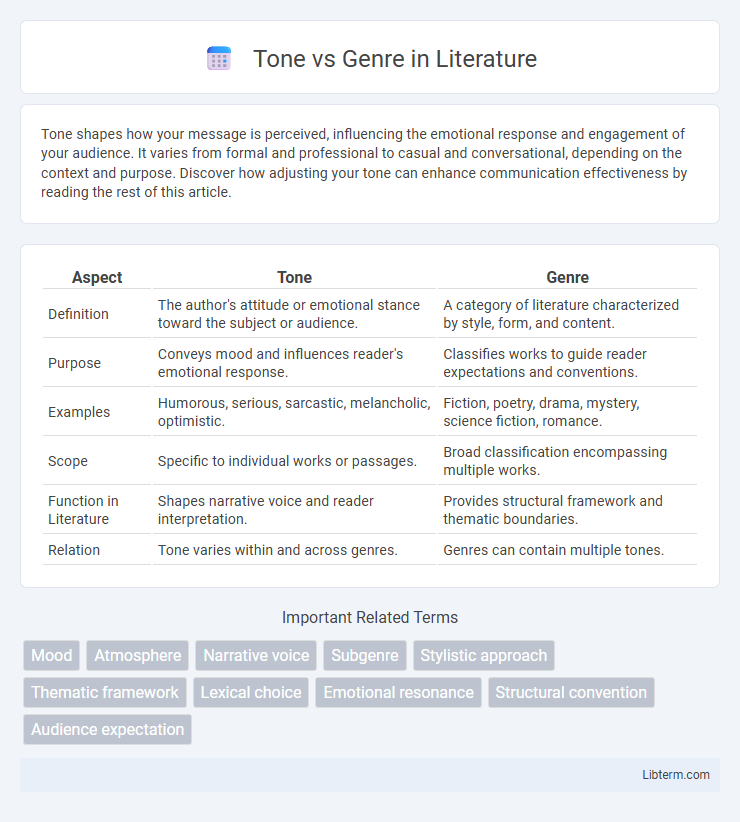Tone shapes how your message is perceived, influencing the emotional response and engagement of your audience. It varies from formal and professional to casual and conversational, depending on the context and purpose. Discover how adjusting your tone can enhance communication effectiveness by reading the rest of this article.
Table of Comparison
| Aspect | Tone | Genre |
|---|---|---|
| Definition | The author's attitude or emotional stance toward the subject or audience. | A category of literature characterized by style, form, and content. |
| Purpose | Conveys mood and influences reader's emotional response. | Classifies works to guide reader expectations and conventions. |
| Examples | Humorous, serious, sarcastic, melancholic, optimistic. | Fiction, poetry, drama, mystery, science fiction, romance. |
| Scope | Specific to individual works or passages. | Broad classification encompassing multiple works. |
| Function in Literature | Shapes narrative voice and reader interpretation. | Provides structural framework and thematic boundaries. |
| Relation | Tone varies within and across genres. | Genres can contain multiple tones. |
Understanding Tone in Storytelling
Tone in storytelling reflects the author's attitude toward the subject, shaping the reader's emotional experience through word choice, sentence structure, and narrative style. It establishes the mood, whether it is somber, humorous, or suspenseful, influencing how the audience perceives characters and events. Unlike genre, which categorizes a story by its thematic elements and conventions, tone guides the subtle emotional signals that enhance immersion and interpretation.
Defining Literary Genre
Defining literary genre involves categorizing works based on shared conventions, themes, and narrative structures that guide readers' expectations. Tone, reflecting the author's attitude or emotional stance, varies within genres but does not determine the genre itself. Recognizing genre helps contextualize tone, enabling a deeper understanding of the work's stylistic and thematic purpose.
Key Differences Between Tone and Genre
Tone refers to the author's attitude or emotional stance conveyed through word choice and style, while genre categorizes a work based on content, structure, and thematic elements, such as fiction, non-fiction, mystery, or romance. Tone can shift within a single genre, creating variations like a serious tone in horror or a humorous tone in science fiction, whereas genre remains consistent, defining the overall framework of the narrative. Understanding the distinction helps in analyzing literature by separating emotional atmosphere from the type or category of the story.
How Tone Shapes the Reader’s Experience
Tone shapes the reader's experience by influencing emotional perception and engagement within a genre's framework. A dark, somber tone evokes feelings of tension and unease, enhancing the impact of horror or thriller genres, while a lighthearted, humorous tone creates an atmosphere of enjoyment and relaxation in comedy or romance. The interplay between tone and genre determines how readers interpret themes, characters, and narrative moods, ultimately guiding their emotional journey through the story.
The Influence of Genre on Story Structure
Genre profoundly shapes story structure by establishing specific conventions and expectations that guide plot development, character arcs, and pacing. For example, mystery genres often prioritize a structured buildup of suspense and clues, while romance genres typically follow an emotional progression centered on relationship dynamics. This genre-driven framework influences how tone is deployed to reinforce thematic elements and audience engagement throughout the narrative.
Examples of Distinct Tones Across Genres
Mystery novels often employ a suspenseful tone, creating tension with dark, foreboding language, while comedies use a lighthearted, humorous tone to evoke laughter through witty dialogue and situational irony. Horror stories maintain a chilling, eerie tone by incorporating unsettling descriptions and a pervasive sense of dread, contrasting sharply with romance novels that utilize a warm, passionate tone filled with emotive language and intimate moments. Science fiction frequently adopts a speculative, futuristic tone, characterized by imaginative concepts and analytical narration, which differs greatly from fantasy's epic, adventurous tone, rich with mythical imagery and heroic quests.
Why Genre Doesn’t Dictate Tone
Genre establishes the overarching category of a story, such as horror, romance, or science fiction, but tone reflects the author's attitude and emotional atmosphere conveyed through style and word choice. A single genre can encompass a wide range of tones, from dark and suspenseful to lighthearted and humorous, allowing for diverse reader experiences within the same category. Understanding that tone operates independently of genre enables writers to craft unique narratives that defy conventional expectations while retaining genre elements.
Adapting Tone Within a Single Genre
Adapting tone within a single genre involves shifting the emotional and stylistic nuances to create varied reader experiences while maintaining genre conventions. For example, a horror story can employ a dark, suspenseful tone or a more humorous, satirical tone without changing its classification. This flexibility enhances narrative depth and audience engagement by aligning tone choices with plot developments and character arcs.
The Importance of Matching Tone to Genre
Matching tone to genre is crucial for creating cohesive and engaging content that meets audience expectations and enhances storytelling effectiveness. For example, a horror genre typically requires a dark, suspenseful tone to evoke fear, while a comedy demands a lighthearted, humorous tone to entertain. Misalignment between tone and genre can confuse the audience and weaken the impact of the narrative or message.
Crafting Stories: Balancing Tone and Genre
Crafting stories requires a strategic balance between tone and genre to engage readers effectively. Tone establishes the emotional atmosphere, whether dark, humorous, or suspenseful, while genre defines structural expectations like mystery, romance, or fantasy. Successful storytelling weaves tone seamlessly within genre conventions to create immersive and emotionally resonant narratives.
Tone Infographic

 libterm.com
libterm.com